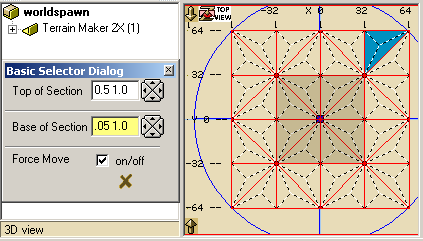|
Our next two buttons on the Terrain modes toolbar are really two functions acting as one for the time being. The first one is the Selector Dialog Input button and the second is the button which uses the first one, our Basic Selector.
|

|
The Basic Selector is the one we have been using through out these demonstrations. So you should be fairly familiar with its operation by now. The Selector Dialog Input function however, is a whole other matter that's adds real punch to the Basic Selector's functionality and capabilities.
Once a selection has been made, using the Basic Selector, the Selector Dialog Input button becomes active, or usable for that particular function button, and by clicking it, will now open the dialog box. As you have probably figured out by now, these are adjusters that can be applied to the Basic Selector to cause it to render different shapes to the dragging process. And because they are virtually unlimited, so are the possibilities that it can give.
|

|
The very first time the Dialog Box is used its default values will be preset and show in the two input areas. These values are also shown in the 'hint pop-up box' of the Basic Selector's button and can be viewed by holding your mouse cursor over that button for a second. As a general note, sense they work together, if one value is set to zero then the other will have no effect.
The first input box of the dialog, in this case, effects the very top of the selection, which means where one point of each face meets the center handle when looking at it in the Top View of the editor, and is shown slightly darker in the screen shot above.
The second input box will deal with the rest of the selection in the same manner. Each input box takes two individual values. The first value represents a percentage factor that will be applied to the second value, which is the amount of units that will be added to the Basic Selector's movement during a particular drag. Meaning, that you can start a drag, pause, set a different set of values and then continue the drag once again. Or, you can do the same process but this time make a new selection of an area and apply the new settings just to those faces. So as you can see now, the possibilities are virtually unlimited !
The third check box is an entirely different setting. This function is used for special situations when faces will not move as sometimes occurs with Imported Terrains or you wish to move faces that normally would not move. When this tool is activated the above adjusters will also influence its movement and it too is an item you can use on the fly like the ones above. When using this feature on the down faces set one of the two entered amounts as a negative because you are working in a revered direction. A little experimentation will help a lot.
To make things easer while using the Dialog Box it has its own built in features. It will remain open and stay focused on top of the editor until you decide to close it so changes can be made on the fly. It can also be resized like any other window and moved to any location of your choosing by simply putting your mouse cursor over the blue title area at the top, and while holding down your LMB drag it to its new location.
One final feature is that once the dialog box settings are changed they are stored and saved to keep them the same until you change them again in another session of QuArK. Also, it can remain either open or closed during the dragging process and its settings will still take effect.
The reason I said it ''becomes active, or usable for that particular function button'' earlier is because as new selectors, or even tools, are added for QuArK's Terrain Generator they too can have their own dialog input boxes to further enhance the features that they will provide as well.
A few items that need to be covered about the Basic Selector are these. Like the QuArK's Standard Selectors, it can select individually other types of items like the 'Terrain Shape Builders' , it can also drag them or their side handles in the editor's views. But it can not select a group of other standard items such as regular polys and entities using the drag selection method. To do this you will need to use one of the QuArK Standard Selectors. On the other hand, it can do things that the standard selectors can not do. The most important being the ability to select terrain surface right through every thing else, like other polys and entities. This means that you do not need to hide, move or work around these other items. That was the whole bases of why QuArK's Terrain Generator was developed. The ability to create and edit terrain around all other mapping items while they are being displayed in the editor.
|
|
The selection process itself is also different for a very specific reason. Where the QuArK Standard Selectors will select any poly that it touches, the Basic Selector will not. Instead, it only selects a face if the center point of that face is within the selector's red rectangular selection box. It was designed this way so that odd and ill regular selections could be made.
|
|
Another nice feature of the Basic Selector is its ability to select only surface faces to aid in the process of texturing the terrain. More on the subject of using the Basic Selector for texturing techniques is covered on the 'Texture' page.
|
|